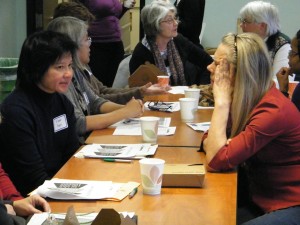 In last week’s mentor workshop, YouthWorks staff and worksite mentors had the opportunity to explore the concept of learning styles.
In last week’s mentor workshop, YouthWorks staff and worksite mentors had the opportunity to explore the concept of learning styles.
Each individual has her / his own preferred way to learn something new. While there are many different possible learning types, there are three basic categories. Visual learners prefer to learn by seeing information or instructions presented in a demonstration, illustration, or written format. Auditory learners learn best by hearing or discussing information. Kinesthetic learners prefer a hands-on approach to new tasks.
Knowing an intern’s preferred learning style(s) can help worksite mentors to provide instruction in a way that can be most easily understood and remembered. In our workshop, mentors were grouped by learning style to come up with strategies for providing instruction to different types of learners.
Visual learners were the most numerous group. Their recommended instructional strategies for those of their type included:
- Create task lists for visual learners, or support interns in keeping their own lists.
- Demonstrate how to do something and have intern observe and take notes (both for initial instructions and to point out errors).
- Where available, use instructional videos or podcasts.
- Create and post diagrams, photos, charts or legends for important technologies or processes in the office.
- Encourage youth to take written notes or to draw pictures, and provide a place to keep those notes for regular reference.
Auditory learners suggested the following instructional ideas:
- Provide clear and concise verbal instructions to auditory learners.
- Highlight key words in your instruction, and make sure interns know what they mean.
- Ask the intern to repeat back a set of instructions to ensure s/he understands it.
- Discuss the full scope of a project with an intern to provide context.
- Invite questions and talk through all problems throughout the learning process.
The Kinesthetic group prioritized strategies such as:
- Provide hands-on opportunities for youth to learn from experience.
- Encourage youth to try things and to make mistakes and learn from them.
- Enable youth time for experimentation
- Provide opportunities for youth to write down instructions or to physically describe how they will approach a new task.
- Assign tasks that have opportunities for physical involvement.
Hopefully these ideas will support mentors in continuing to expand their own strategies for providing effective instructions to interns, and to decrease possible challenges in communication at the workplace.